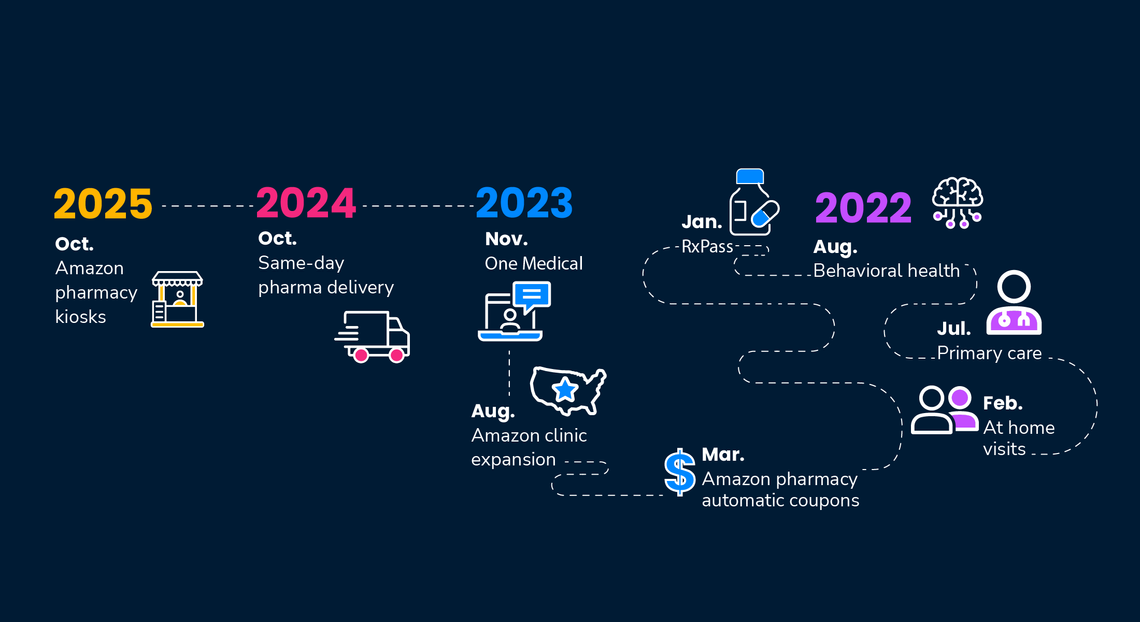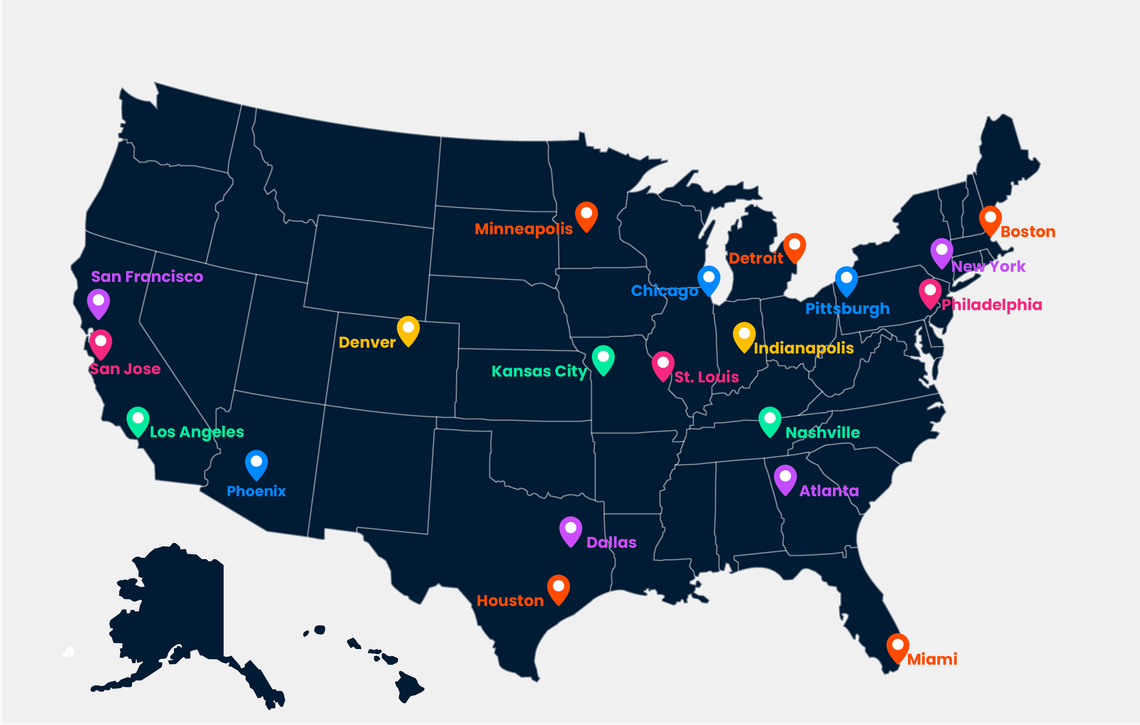
Amazon extends its pharmacy reach to the doctor’s office
By Callie Troutman, MPH, MS, RDN, CHES, Associate Director, Learning Strategy; Imre Varju MD, PhD, MPH, CHES, VP Learning Strategy; Sophie Blais Banspach, MPH, CHES, Senior Learning Strategist at YuzuYello
Our authors have updated this thought leadership piece based on the latest Amazon healthcare news.
Amazon is breaking the mold again when it comes to purchasing medications. Starting in December, Amazon will be rolling out "pharmacy kiosks" which are pharma vending machines available at select One Medical locations in the Los Angeles area. These self-service kiosks will stock a wide range of commonly prescribed medications, including antibiotics, inhalers, treatments for blood pressure, as well as flu and allergy medications during relevant seasons.
According to Amazon, patients can collect their prescribed medications just minutes after their appointment by scanning a QR code in the Amazon app, allowing them to bypass brick-and-mortar pharmacies.1 By removing an extra stop after a doctor’s visit, this could help patients overcome a common barrier and begin their prescribed treatment without delay.
Pharma companies can create key touchpoints with these new kiosks by incorporating their saving cards into the Amazon programming to help make medications even more accessible and affordable. It can also be an ideal moment to encourage patient support program enrollment at this timely point of purchase.
Amazon is expected to expand their kiosks to other One Medical offices in 2026.
New Year, new access: Amazon Pharmacy to expand same-day delivery to 20 more cities
Originally published October 2024
As the days get shorter and holiday to-do lists grow, Amazon Pharmacy is ringing in the new year with same-day delivery to 20 more cities.2 Starting in 2025, this expansion will more than double its current reach.
The impact? More people getting the medicines they need, when they need them. Right now, Amazon Pharmacy customers usually get their medications in two days or less. But with this expansion, patients will get their prescriptions just hours after they’re ordered.
“In healthcare, speed and accessibility are key for positive outcomes,” said Dr. Vin Gupta, Chief Medical Officer at Amazon Pharmacy.
But does faster delivery really matter? Amazon thinks so. When people know their medicine will arrive quickly, they’re more likely to order it. And starting treatment right away helps patients stay on track, improving health outcomes. With same-day delivery, people can take control of their health without delay.
The Amazon road to healthcare

October 2024: Amazon Pharmacy announces plans to expand same-day delivery to 20 more cities in 2025
November 2023: Amazon introduces new healthcare benefit for prime members, offering 24/7 access to virtual care with One Medical.
August 2023: Amazon Clinic expands its virtual healthcare marketplace nationwide.
March 2023: Amazon Pharmacy launches a new feature to automatically apply manufacturer-coupons at checkout for eligible patient orders.
January 2023: Amazon announced RxPass that gives Prime subscribers access to over 50 generic medications for $5/month.
Amazon Care:
August 2022: Amazon announced it would be shutting down Amazon Care for all employers by the end of the year.
Amazon Care – Behavioral Health:
August 2022 : Amazon announced partnership with digital mental health company Ginger.
Amazon Care - Primary Care:
July 2022: Amazon announced acquisition of primary care provider One Medical.
Amazon Care - At home visits:
February 2022: Amazon announced at-home care services are expanding to more than 20 new cities (see below) in 2022, bringing even more care options to Amazon Care’s growing customer base.
Amazon Care - Telehealth:
Launched in 2019 as a telehealth provider to Amazon employees. In 2021, they extended the service to all Washington state businesses and now has been expanded nationwide to other companies.
In November 2021, Amazon announced they will provide all Hilton employees access to Amazon Care.
Amazon Diagnostics:
May 2021: Amazon announced they will be making at-home Covid-19 testing kits and will possibly expand to other respiratory infections.
Amazon Pharmacy:
November 2020: Amazon announced two new pharmacy offerings for customers to purchase medications:
- Amazon Pharmacy: a new store on Amazon that allows customers to purchase medications, manage insurance prescriptions.
- Prime Rx: Prime members who do not have insurance can save money at both the Amazon pharmacy as well as at over 50,000 other participating pharmacies nationwide.
Amazon Together / Amazon Care Hub:
Alexa is a HIPAA compliant device which opens the door to healthcare applications.
November 2020: Alexa Care Hub, a service meant “to help aging customers maintain independence and provide assurance to family members.” It ties two Echo Dots, Echo Shows, or other Echos together so families could check on elderly loved ones at any time.
September 2021: Alexa Care Hub was rolled into Alexa Together- a subscription service that includes features like:
- If a senior says, “Alexa, call for help,” Amazon will connect them to someone who can can get them help or call an ambulance.
- Fall detection: Alexa Together includes fall detection devices from Vayyar and SkyAngelCare. If a person falls while wearing a device, a message is sent through the Echo to the Urgent Response team.
PillPack:
These launches and announcements follow the Amazon acquisition of PillPack in 2018.
What is Amazon Care?
As with everything Amazon does, their goal (and headline) is: Healthcare Made Easy. As of last summer, around 40,000 people were enrolled in Amazon Care, most of which were Amazon employees, but it’s expected with 2022 expansions, this number will greatly increase as enrollment has been expanded beyond Amazon.3
In 2019, Amazon created their own telehealth platform for Amazon employees. Was this a test for them to see how they can compete in the telehealth market? To work out any kinks in a protected space? And they didn’t partner with one of the major telehealth companies, rather they built their own platform. And it’s built to meet various needs of the users.
There are 2 main parts to the service:
1) Virtual Care, which connects patients to medical professionals via the Amazon Care app (available for both Android and iOS) and allows patients to quickly, conveniently, and confidently chat live with a nurse or doctor, via in-app messaging or video.

2) In-person care, where Amazon Care can dispatch a medical professional to a patient’s home for additional care, ranging from routine blood draws to listening to a patient’s lungs, and also offer prescription delivery right to a patient’s door.4

If the patient is in a market that has at-home services and they require an in-person visit with a provider, Amazon Care deploys a mobile clinician who shows up at the user’s door typically in 60 minutes...according to Amazon. The service also can deliver medications to users within 120 minutes.5
At-home locations expected by the end of 2022 include:

Community, accessibility, empathetic care
Often times with telehealth, it feels the objective of the service is just convenience. But Amazon is going further - focusing on the whole patient - and addressing what has felt like a void in recent medical interventions.
On the website, you can watch a video to hear their mission as told by their practitioners.

Amazon Web Services is also powering the pharma industry
Amazon also is a major player and supports 9 of the 10 top pharma with their AWS platform. With over 130 HIPAA-eligible services, they support pharma throughout the drug development and commercialization process. But that’s a POV for another day!6

What does this Amazon Care mean for pharma?
As will all telehealth providers, patients are by-passing HCP offices. HCPs may not be detailed and we have less opportunities to reach patients at the point of care. But remember, a patient may use telehealth for one indication, but can certainly show up in the doctor’s office for a different indication.
So as always, pharma needs to be where the patient is. Whether that’s digital, out of home or at the pharmacy. And provide them with the tools, resources and support to get the best possible outcomes.
References
1 Amazon to start offering prescription drugs through vending machines
2 Amazon plots big expansion of pharmacy business, adding same-day delivery in 20 cities next year
